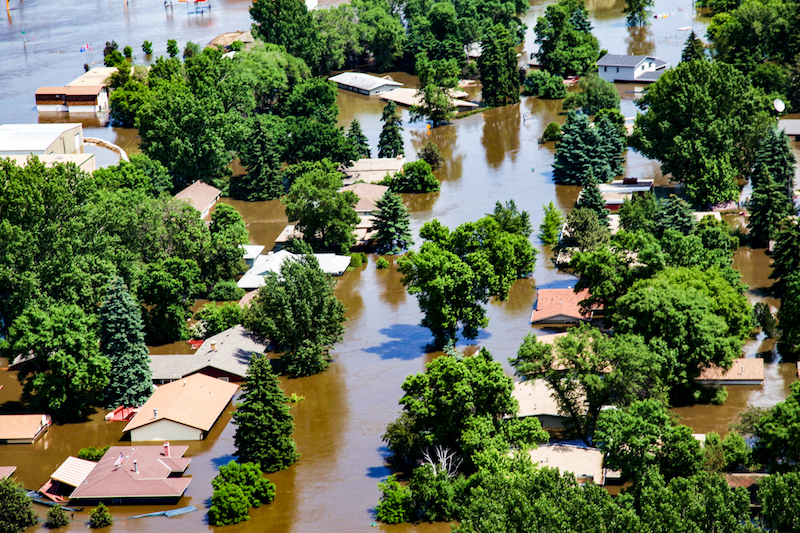Last June, Minot, N.D., received $74.3 million it was awarded in January 2016 as one of the winners of HUD’s resilience competition. The city, which was hit hard by flooding in 2011, will use that money over the next five years to reduce flood risks and improve water quality, build resilient and affordable neighborhoods, and diversify its economy.
This is part of a much larger flood-control effort that could cost up to $700 million, and involves FEMA, the Army Corps of Engineers, the state of North Dakota, and Minot, which will kick in $337 million over the next decade, says John Zakian, a former consultant with New York City’s resilience program, who now manages Minot’s National Disaster Resilience Program.
About half of the HUD money, $20 million, is financing the buyout of 170 single-family homes, and 190 total properties, along the river, tearing them down and turning that area into wetlands and flood barriers. Another $12 million was set aside for building multifamily housing, and to acquire property for a homeless shelter and downtown park, outside of the new flood plain.
Zakian says the city mandated the sale of the homes, but only had to invoke eminent domain on three houses.
Minot’s actions are further evidence that climate-induced migration—a/k/a relocation of populations at risk—is no longer off the table for municipalities as part of their disaster resilience strategies. And with FEMA’s National Flood Insurance Program already $25 billion in debt to the U.S. Treasury, rebuilding in vulnerable areas gets more financially precarious by the day.
“Eventually, people are going to have to face up to this reality,” says Rachel Minneri, who oversees AIA’s disaster assistance, resilience, adaptation, and sustainable community development programs. She points out that while FEMA doesn’t publish information about relocations, they’re actually a lot more common than is generally perceived.
Some examples of places where relocations are more than idle chatter:
- After being flooded in 2013, Boulder County in Colorado initiated a “Building Back Better” program that included buying back flood-damaged properties that would pose a future high risk, and turning those properties into undeveloped land in perpetuity. The county paid $26.8 million to acquire 46 properties, and was wrapping up demolition in September 2017;
- Hundreds of residents in Ottawa, Ont., abandoned their homes to escape record flooding in April. The city has told homeowners they could apply for government assistance to rebuild or repair one more time, and that’s it;
- Oregon school districts have been pulling schools out of tsunami zones, says Erica Fischer, PhD, PE, an assistant professor at Oregon State University who, until last August, was a design engineer with Degenkolb Engineers;
- Louisiana’s new master plan calls for paying 20,000 coastal residents to relocate. The state is currently engaged in a $48 million pilot program that includes relocating residents of 29 homes on Isle de Jean Charles, a narrow island that’s sinking into the Gulf of Mexico.
It’s worth noting, too, that only 17% of Houston-area homeowners have flood insurance, and federal disaster relief is capped at $33,000, hardly enough on its own to rebuild a destroyed house.
But convincing people to relocate is a psychological hurdle: just look at how many ignore evacuation orders, or keep returning, year after year, to regions afflicted by floods, tornados, and fires. Mandated relocation also devalues the forsaken property. And what still isn’t clear, says Josh Sawislak, AECOM’s Global Director of Resilience, is the value of such property beyond its existing primary function.
But if the government and insurers start cutting off, or even significantly reducing, dollars to rebuild and restore, resilience is going to mean relocation for a lot more at-risk Americans. “Those discussions are going to happen,” says Illya Azaroff of +LAB Architects and Experimentation in Brooklyn, N.Y., which has started downzoning coastal neighborhoods like Red Hook, and upzoning places outside of the borough’s flood plain.
Related Stories
Urban Planning | Oct 12, 2023
Top 10 'future-ready' cities
With rising climate dilemmas, breakthroughs in technology, and aging infrastructure, the needs of our cities cannot be solved with a single silver bullet. This Point2 report compared the country's top cities over a variety of metrics.
Building Materials | Oct 2, 2023
Purdue engineers develop intelligent architected materials
Purdue University civil engineers have developed innovative materials that can dissipate energy caused by various physical stresses without sustaining permanent damage.
Resiliency | Sep 25, 2023
National Institute of Building Sciences, Fannie Mae release roadmap for resilience
The National Institute of Building Sciences and Fannie Mae have released the Resilience Incentivization Roadmap 2.0. The document is intended to guide mitigation investment to prepare for and respond to natural disasters.
Codes and Standards | Sep 25, 2023
Modern codes, construction techniques saved structures in Maui wildfire
Modern building codes and construction techniques were effective in saving buildings from the devastating wildfire in Maui on August 9th, according to a recent report, IBHS Early Insights Lahaina Fire—2023, from the Insurance Institute for Business and Home Safety’s research division.
Mass Timber | Sep 19, 2023
Five Things Construction Specialties Learned from Shaking a 10-Story Building
Construction Specialties (CS) is the only manufacturer in the market that can claim its modular stair system can withstand 100 earthquakes. Thanks to extensive practical testing conducted this spring at the University of California San Diego (UCSD) on the tallest building ever to be seismically tested, CS has identified five significant insights that will impact all future research and development in stair solutions.
Engineers | Sep 15, 2023
NIST investigation of Champlain Towers South collapse indicates no sinkhole
Investigators from the National Institute of Standards and Technology (NIST) say they have found no evidence of underground voids on the site of the Champlain Towers South collapse, according to a new NIST report. The team of investigators have studied the site’s subsurface conditions to determine if sinkholes or excessive settling of the pile foundations might have caused the collapse.
Resiliency | Sep 11, 2023
FEMA names first communities for targeted assistance on hazards resilience
FEMA recently unveiled the initial designation of 483 census tracts that will be eligible for increased federal support to boost resilience to natural hazards and extreme weather. The action was the result of bipartisan legislation, the Community Disaster Resilience Zones Act of 2022. The law aims to help localities most at risk from the impacts of climate change to build resilience to natural hazards.
Metals | Sep 11, 2023
Best practices guide for air leakage testing for metal building systems released
The Metal Building Manufacturers Association (MBMA) released a new guidebook, Metal Building Systems - Best Practices to Comply with Whole-Building Air Leakage Testing Requirements.
Codes and Standards | Aug 31, 2023
Community-led effort aims to prevent flooding in Chicago metro region
RainReady Calumet Corridor project favors solutions that use natural and low-impact projects such as rain gardens, bioswales, natural detention basins, green alleys, and permeable pavers, to reduce the risk of damaging floods.
Sustainability | Aug 15, 2023
Carbon management platform offers free carbon emissions assessment for NYC buildings
nZero, developer of a real-time carbon accounting and management platform, is offering free carbon emissions assessments for buildings in New York City. The offer is intended to help building owners prepare for the city’s upcoming Local Law 97 reporting requirements and compliance. This law will soon assess monetary fines for buildings with emissions that are in non-compliance.
















